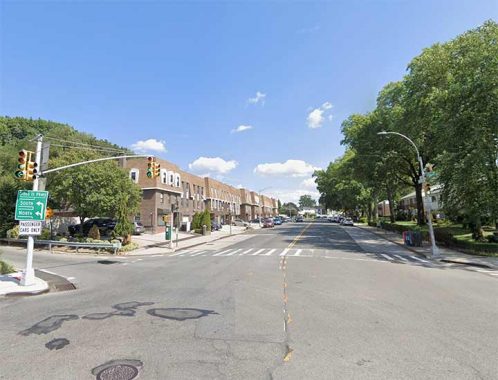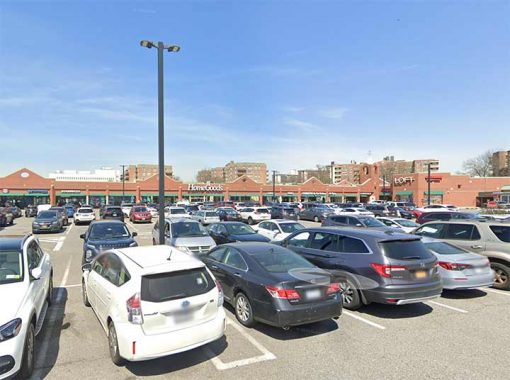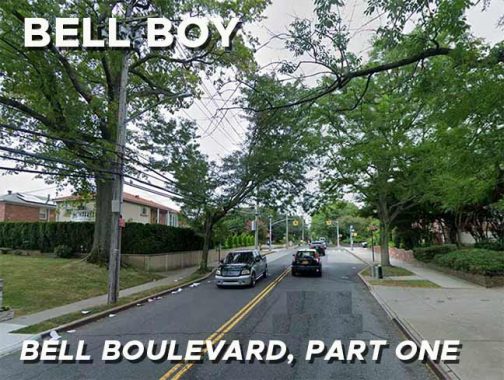
In November and December it struck me that I had never walked Bell Boulevard all the way from north to south, despite living in eastern Queens in Flushing and Little Neck for an even 30 years. Newly mobile again after hernia surgery I remedied the situation and found a couple of days around the holidays when it wasn’t raining. However, I still haven’t done the whole length. The stretch between the Cross Island Parkway and the business section at 35th Avenue is lovely but fairly unremarkable, so I did some screen shots via Street View, which explains the leaved trees there and bare trees elsewhere on this post.
Bell Boulevard was not named for the Alexander Graham Bell, who first patented the telephone, but shipping merchant Abraham Bell, who purchased about 250 acres in what is now Bayside in 1824. Bell Boulevard (at first named Bell Avenue) was once the dividing line between his two farms. Bell’s mansion on Bell Blvd. and 39th Avenue remained standing until 1971. However, Alexander will be coming up for a mention in Part Two.
Bell Boulevard is visually interesting: sometimes it’s four lanes, sometimes just two, and toward its south end, is wide enough for six, but has a wide painted median. In Bayside Hills, it’s divided by a grassy median like a number of other wide streets in the area.


The north end of Bell Boulevard is at the two-way Cross Island Parkway service road, 212th Street, and entrances to the CIP proper and Fort Totten, now mostly a recreation area albeit with some control by the NYPD and FDNY. If a motorist/bicyclist were so inclined, (s)he could travel in a straight line from Parsons Boulevard in Flushing all the way down Bell Boulevard by taking Willets Point Boulevard northeast, the service road, and then Bell Boulevard south; or do the route in reverse.

One of Queens’ largest “outdoor” malls is Bay Terrace, which occupies several acres west of Bell Boulevard and north of 26th Avenues. It serves a large area of homes including co-op and condo apartments Bay Terrace, Bayside Towne Houses and the high-rise Bay Club. The Bayside Land Association purchased what had previously been estates and farmland from Cord and Charles Meyer during the 1950s. Dozens of shops anchored by Stop & Shop, Home Goods (you never know when you will need a ceramic rooster), Old Navy and several chain restaurants are available. I was a more regular visitor when a large Barnes & Noble “superstore” was onsite in the 1990s and 2000s, but I have been in Ben’s Kosher on several occasions.
Alas, nothing like this exists in Little Neck within easy reach of FNY headquarters.
Between 26th and 35th Avenues, Bell Boulevard is one of the handsomest major roadways in NYC as it shrinks to two lanes and runs through some of NYC’s premier middle to upper class neighborhoods. It gains more streets trees and travels through a Tudor-dominated section most likely planned by a long ago developer. The Korean Shin Kwang Reformed Church at 33rd Road is a good-looking mostly brick structure.
Tequila Sunrise Mexican, at Bell Boulevard north of 35th Avenue. Named for an Eagles song, it’s the kind of place where a mariachi band plays you “Happy Birthday.”
A Little History
Bayside was first settled by the British around Alley Creek, the East River inlet now leading to Alley Pond Park, in the early 1700s. It was named “Bay Side” in 1798 and by the time the one-word spelling appeared in the 1850s, it was a small but potent community giving rise to governmental leaders and statesmen. The neighborhood has always retained a small-town atmosphere centered around Bell Boulevard.
What began as the Great Bay chrome diner at the SE corner of 35th Avenue and Bell Boulevard in the mid-20th Century subsequently became part of the Jackson Hole hamburger franchise, originated in 1972. During the last couple of years, it has become a Bayside branch of the Neptune Diner, whose flagship on 31st Street and Astoria Boulevard is threatened by developers. In recent years, diners have been under threat from the pandemic and other reasons, as the Bayside, Scobee and Seven Seas diners on Northern Boulevard have all closed or been rebranded.
I don’t do product endorsements, other than the ads on the site (which I do not choose) but Bayside Milk Farm, next to the diner, sells the best chopped sirloin in my stretch of Queens and I am planning a visit later today to purchase same.
What had been a Masonic temple at the NE corner of 36th Avenue and Bell Blvd. in the 1990s when I first moved to Queens was subsequently turned into another house of worship, the Korean Siloam Church; my admiration for brick architecture remains undiminished.
I also have an admiration for cobblestone pavements (but just for admiring them. Walking or bicycling on them is difficult). There are a number of complete or partial cobblestone building exteriors in NYC and here’s one opposite the church. perhaps none as fancifully executed as this one, on the NW corner of Bell Boulevard and 36th Avenue.
The stones are naturally shaped, i.e. not beveled or cut in any way, and give some idea of what NYC street paving was like before cobblestones gave way to flatter Belgian blocks and later, smooth macadam and asphalt. The stones are closely set in concrete. The house was built in 1906 and according to local legend, housed a speakeasy during Prohibition. Utahan actress Maude Adams (1872-1953), who played Peter Pan in over 1500 performances, is thought to have lived in the house during her Broadway days.
This pair of stone pillars seems to have the same cobblestone construction as the house and it’s likely they were also installed in 1906. A close look at the slate or bluestone signs vouchsafes a glimpse into Bayside’s past as they read “Bell Avenue” and 36th Avenue’s original name, Lamartine Avenue. The vast majority of Queens streets were given new names or numbers beginning in 1915 with the process completed in the 1930s, though old names persist, here and on some subway station signs.
In the early 2020s Bell Boulevard business section received a set of retro Triborough Bridge lamps. The original design appeared when the bridge (now officially the RFK) opened in 1936. Forgotten NY marked the bridge’s 75th anniversary with a well-attended tour in 2011. The poles are in a streamlined Moderne style, but there are details such as the ziggurated finials which echo those on NYC skyscrapers. Retro Tribes have appeared on Ditmars Boulevard and Jamaica Avenue in Queeens and Elton andf Hunt’s Point Avenues in the Bronx, as well as mini versions in Hudson River Park.
The Lutheran School of Flushing and Bayside is a handsome one-story ranch-style building, but I was more impressed by its tremendously large lawn, which there must be a story behind.
The name “Gleason” is inextricably bound with Queens: not for the comedian/musician Jackie, whose “Honeymooners” was set in Brooklyn, but for 19th Century Long Island City mayor Patrick “Battle Axe” Gleason, but also for Martin Gleason’s funeral homes. The Bayside entry is rather pedestrian but in Whitestone, Martin A. Gleason Funeral Home, at 11th Avenue and 150th Street, features a corner double-decked round porch with Ionic coulmns. It is a converted Victorian-era private house, one of a number of Gleason funeral homes in the borough; so that’s what they mean by “going in style.”
It’s a guess–I didn’t carry a tape measure–but Bell Boulevard’s tallest steeple is likely the Bayside (Korean) United Methodist Church, midblock on Bell Boulevard between 38th and 39th Avenues, which was dedicated the same year I was. The congregation goes back to 1890, when the area was part of Abraham Bell’s property and the area was still mostly farmland.
Opposite the church is a buff-colored terra cotta building with Corinthian pilasters (half-columns) that is complementary to the former Bayside Theater adjoining it further south at 39th Avenue.
The old Bayside Theatre on the NE corner of Bell Boulevard and 39th Avenue opened in 1927 (as the Capitol Theatre) and was designed by prolific theatre house architect Thomas Lamb. According to cinematreasures commenters, it was closed during much of the Depression, but reopened in 1941:
On November 7, 1941, it had a gala re-opening as the Skouras Bayside. Here’s a report from the Bayside Times: “Stars of stage, screen and radio attended the gala opening of the new Skouras Bayside Theatre, 38-39 Bell Boulevard. Among those who participated were Patti Pickens and Bob Simmons of radio and stage fame; Bob Douglas, NBC’s new singing star; Erik Rhodes, film comedian featured in many Ginger Rogers-Fred Astaire pictures, and others…The theatre has been completely rebuilt and decorated, with only the walls of the old structure retained. The lobby, auditorium and lounges have been furnished in keeping with present-day standards to create the most modern theatre on the North Shore…The new theatre will have complete changes of program twice each week, with special selected programs for children at 10 o’clock every Saturday morning.”
United Artists closed the theatre, which had deteriorated greatly from lack of maintenance, after the weekend of October 14, 2001; “Zoolander” was the final first-billed feature, along with “Rush Hour 2″and a couple other unmemorable productions. The ground floor is now occupied by baked goods emporium The French Workshop; I have to stay away from bakeries, as I could blow out my cholesterol and blood sugar if I was let loose in one.
An aside: I remember as a freshman in college in 1975 a classmate named Marie Malluk interviewed Erik Rhodes for the school paper, the St. Francis College Voice, and it might have possibly been the most in-depth interview of the actor who usually was the foil or second banana during the 1930s golden cinematic era. This was long before the internet age, and I’m not sure I still have that issue.
The blocks between 38th and Northern Boulevard present Bell Boulevard’s greatest array of local businesses, one of which is the optometrist Eye & I. I have noticed something: many eyeglasses shops now seem to have adopted the yellow and black signage color scheme that the Manhattan based Sol Moscot franchise uses. Could be just a coincidence in this case though.
This part of Bell Boulevard is also Bayside’s Restaurant Row with a number of lively bars interspersed with the eateries. I have patronized a number of them especially Press 195, whose chicken sandwiches are enjoyable. Uncle Jack’s Steakhouse, whose flagship on 9th Avenue and West 35th Street near the Garden, has an outlet here. When I worked at the Bayside Times (see below) I would do layouts in the mornings occasionally and I wouldn’t miss top Bagel, whose bread products were the softest I have encountered. Unfortunately a Bayside branch of Woodside’s famed Donovan’s did not click despite my patronage and it closed a few years ago.
Between once and three evenings a week I could be found in the top floor offices of the Bayside Times, a newspaper with about 12 different editions at its peak boroughwide, doing mechanical layouts. I lasted longer here than any other job, from 1996-2009, and my tenure was only stopped by heart surgery the latter year.
Across the street, this building at 41st Avenue with interesting roof moldings, home to another optometrist, has been there since the early 20th Century.
Another bakery I need to stay out of, Martha’s, a liquor store door away from the Manhattan bound railroad platform (see below) is where I get annual holiday cookies and a cup of hot chocolate.
Bayside Train
The Bayside Long Island Rail Road station, from which commuters can get to Manhattan in about half an hour, has always been one of the more attractive on the Port Washington branch. A railroad has run here since 1866, when the Flushing and North Side Railroad, operated by Elizur Hinsdale, ran east through Bayside to Great Neck (Port Washington wasn’t reached till 1896). It became a part of the LIRR, then owned by rubber magnate Conrad Poppenhusen, in 1876. The present gambrel-roofed station (41st Avenue and 213th Street) dates to 1923, and the tracks themselves were placed in an open cut in 1927; till then, they ran across Bell Boulevard via a gate crossing.
Until 1998 Bayside employed a wooden covered bridge (supported on concrete) that was one of the very few, if not the only, wooden covered bridges in New York City. It has been replaced with a modern steel bridge that is open to the elements on each side, but is otherwise an improvement over its splintering forebear.
The Long Island Rail Road (two words, as they have always spelled it) renovated most of the stations on my line, the Port Washington Branch, in the 1990s and 2000s and by far the handsomest re-do has been the Bayside station, which gained a cross-track walkway (as Murray Hill also has) that features wrought-copper artwork.
“Bayside Story” features spiral friezes that wrap around the support columns, bearing animal and floral motifs as well as bronze reliefs that celebrate local history and culture. Indians paddling a canoe have a central position in the work. Around them are a settler’s homestead, a Revolutionary war soldier, a farm, and Fort Totten. Boxer “Gentleman Jim” Corbett represents local heroes; a yacht and checkered flag portray local amusements. Once home to the Native American Matinecocks, in the late 1800s, the wealthy built estates in Bayside. In the early 1900’s, the community was the home to stars of the silver screen.
Commenting on the artwork, Ed McGowin, stated, “Community history can so easily be lost or forgotten…I consulted with the Bayside Historical Society and the community to choose significant local events and people….” The compelling result proudly tells the story of Bayside. [MTA Info]
I was also able to sneak inside the station for a peek; it’s closed on weekends, but I was by on a Friday.
One of the LIRR’s “Easter eggs” at Bayside is the continued presence of a freight building, long unused since the LIRR ceased to be a freight carrier long ago. Goods were unloaded on the platform and onto an elevator within the building and unloaded on 41st Road. The building, accessible from 41st Road, how houses the Bayside Business Association.
Some interesting terra cotta work on a for-rent storefont next to the railroad.
You can call me boring or overly wedded to habit, but I would eat at either of two long-gone establishments at Bell Boulevard and 42nd Avenue once per week while filling the night shift at the Bayside Times. I would take the train from my day job in Port Washington to Bayside and then have dinner at the Gold Star Diner, where the Indian restaurant is, or at a McDonald’s across the street, where the Benjamin Moore is. I would take a mile walk up to Corporal Kennedy Street before eating, since I was seated all day at the World’s Biggest Direct Mailer and later at the newspaper, just for some exercise.
A staid matron of Bayside on 42nd Avenue along the railroad is the Bayside National Bank building, later tenanted by other banks but today a Chase branch, which happens to be my bank.
The one-story brick building at the NE corner of Bell Boulevard and 43rd Avenue is late 20th Century Functional, but here used to stand the lively French Second Empire Straitton-Storm Cigar Factory, constructed in 1872 and was indeed a factory though it didn’t look like one. Just to the east, a group of attached worker’s housing also stood; in the era, many manufacturers built “company towns” for their employees, as William Steinway (pianos) and Lalance-Grosjean (kitchenware) did for their workers in Astoria and Woodhaven. Alas all trace of Bayside’s smoky past has vanished. The company produced White Owl cigars.
Both these buildings are fairly unchanged from the mid-20th Century; the corner building was the Bank of Manhattan while the brick building next to it has windows only for show, as they have been blocked off since the building was erected. It houses relay switches originally used by… Bell Telephone.
Benjamin Fried Boulevard was subnamed in 2014, honors the local entrepreneur who owned Benn’s Hardware at 42-29 Bell Blvd. for over 65 years.
Speaking of longstanding businesses, there’s been a White Castle on the NW corner of Bell Boulevard and Northern Boulevard since 1932, when the small building you see in the older picture opened. The latest in a succession of White Castle restaurants on the site went up in 1987 and is the one you see there today. It was recently renovated, but I didn’t see much difference when I stopped in after shooting the picture.
The chain originated in 1921 in Wichita, Kansas by cook Walter Anderson and insurance agent Billy Ingram. It was decided to feature white in the color scheme to promote cleanliness, as ground beef was, at the time, unpopular in the wake of Upton Sinclair’s The Jungle, which described unsanitary conditions in the meatpacking industry. For several decades, the restaurants were prefabricated porcelain buildings, like the one here.
For years, there were copycat restaurants with similar names, like White Tower (later the Orange Hut on Broadway and Northern Boulevard in Woodside) as well as New Jersey’s White Mana and White Manna restaurants, both still active.
I like White Castle sliders, but they always seem to make a repeat appearance.
Next: on to Hollis Hills.
As always, “comment…as you see fit.” I earn a small payment when you click on any ad on the site. Take a look at the new JOBS link in the red toolbar at the top of the page on the desktop version, as I also get a small payment when you view a job via that link.
1/7/24
